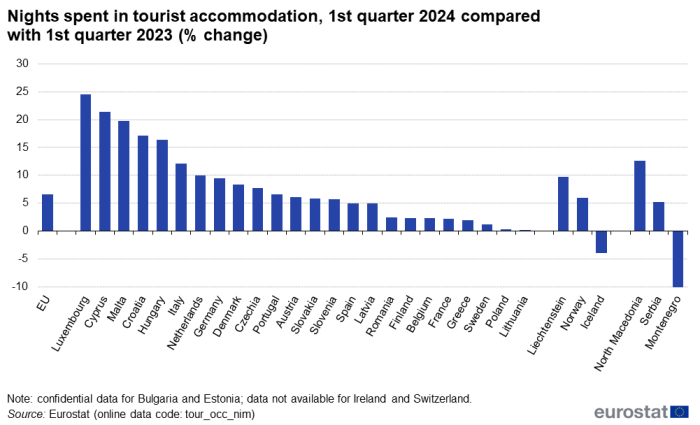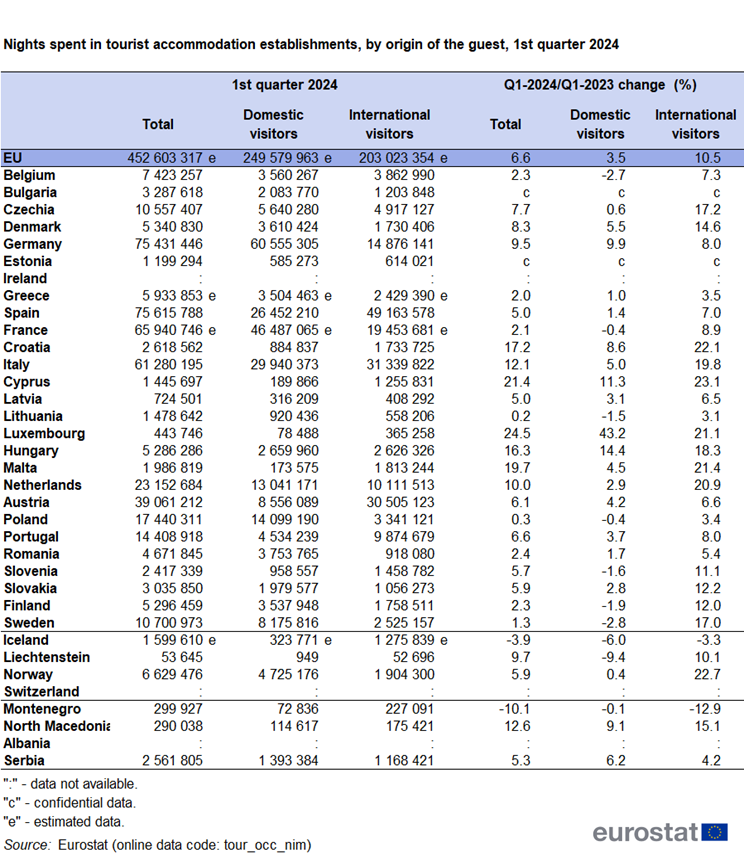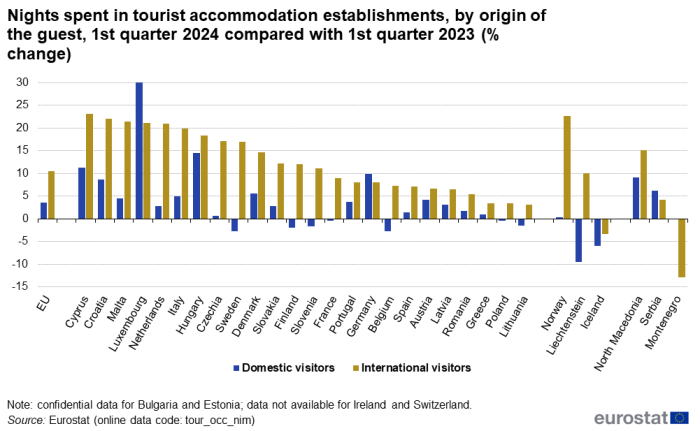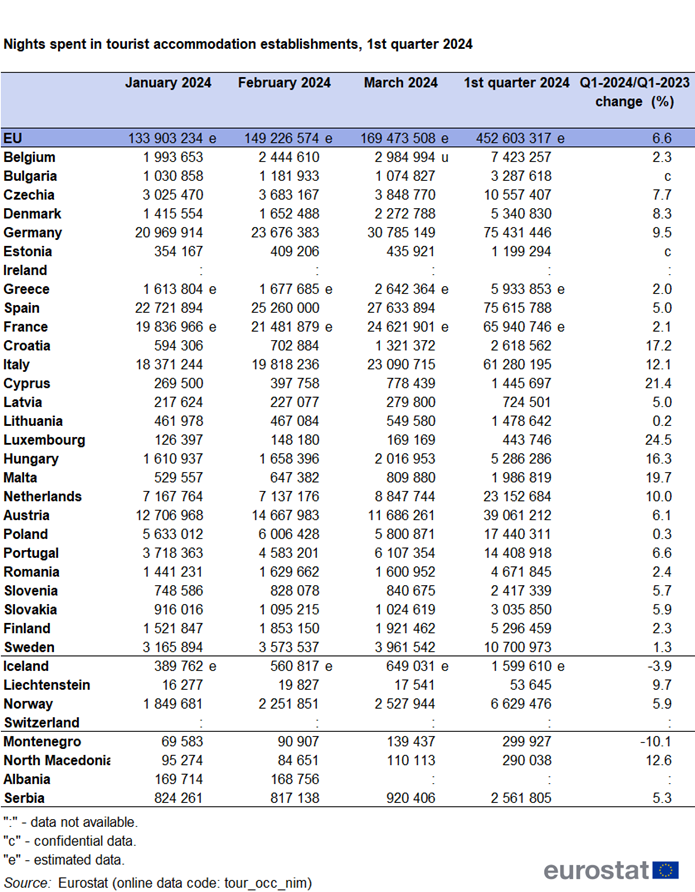Tourism overnight stays to reach 453 million in Q1 2023
In the first three months of 2024, the number of overnight stays in tourist accommodation in the EU was 452.6 million (see table 1). This is 27.8 million (+6.6%) more overnight stays than in the first quarter of last year. All EU countries for which data are available reported a positive trend compared to the first quarter of 2023. The largest increases were recorded in Luxembourg (+24.5%), Cyprus (+21.4%), Malta (+19.7%) and Croatia (+19.7%) (see figure 1). In absolute numbers, the largest contributions to the overall increase were made by Italy (+6.6 million overnight stays), Germany (+6.5 million overnight stays), Spain (+3.6 million overnight stays), Austria (+2.2 million overnight stays) and the Netherlands (+2.1 million overnight stays), with 27.8 million overnight stays, which together accounted for more than three-quarters of the EU increase.
Nights stayed in January, February and March 2024 exceeded the figures for the same periods in pre-pandemic 2019. Nights stayed in Q1 2024 increased by 24.5 million nights (+5.7%) compared to Q1 2019.
 Table 1: Tourist accommodation nights, Q1 2024
Table 1: Tourist accommodation nights, Q1 2024
Source: Eurostat (tour_occ_nim)
 Figure 1: Number of nights stayed in tourism accommodation in Q1 2024 compared to Q1 2023 (percentage change)
Figure 1: Number of nights stayed in tourism accommodation in Q1 2024 compared to Q1 2023 (percentage change)
Source: Eurostat (tour_occ_nim)
International tourism sees double-digit growth in Q1
Looking at the origins of overnight stays, international tourism (+19.3 million overnight stays, +10.5%) contributed more to the overall increase in overnight stays than domestic tourism (+8.5 million overnight stays, +3.5%) in the first quarter of 2024 compared to the first quarter of 2023 (see Table 2).
International tourism in the first quarter increased by more than 20%, with particularly strong gains in Cyprus (+23.1%), Croatia (+22.1%), Malta (+21.4%), Luxembourg (+21.1%) and the Netherlands (+20.9%) (see Figure 2). More than half of the international overnight stays in the first quarter (111 million out of 203 million) were observed in Spain (49.2 million, almost a quarter of all international overnight stays), Italy (31.3 million) and Austria (30.5 million). Increases in international tourism were also observed in all other EU Member States for which data are available.
In absolute terms, domestic tourism was the main contributor (249.6 million nights) out of the 452.6 million nights spent in tourist accommodation across the EU in the first quarter. Between January and March, German residents spent 60.6 million nights in Germany (+9.9% compared to Q1 2023). France saw a slight decrease (-0.4%) in stays by residents with 46.5 million nights. A further six EU countries (out of 24 where data is available) saw fewer domestic tourist nights in Q1 2024 than in the same period in 2023.
 Table 2: Number of overnight guests in Q1 2024 (by guest’s place of origin)
Table 2: Number of overnight guests in Q1 2024 (by guest’s place of origin)
Source: Eurostat (tour_occ_nim)
 Figure 2: Number of nights stayed in tourist accommodation by guest origin, 1Q 2024 vs 1Q 2023 (percentage change)
Figure 2: Number of nights stayed in tourist accommodation by guest origin, 1Q 2024 vs 1Q 2023 (percentage change)
Source: Eurostat (tour_occ_nim)
Hotel nights increased by 18 million in the first quarter
Two of the three types of tourist accommodation showed an increase in the first quarter compared to the same period in 2023 (see table 3). The hotel and similar accommodation segment showed the largest increase in absolute terms, increasing by 18.5 million overnight stays (+6.0%). This segment accounted for 72.3% of tourist accommodation. The number of overnight stays in holiday and other short-stay accommodation (which account for 24.9% of the tourist accommodation market) increased by 11.2%, while the smaller segment of campsites decreased by 14.0% (although in the winter months of January, February and March, campsites only account for 2.8% of all overnight stays). A significant part of the 12.6 million overnight stays in campsites (4.8 million) was recorded in Spain.
 Table 3: Number of nights stayed by accommodation type (Q1 2024)
Table 3: Number of nights stayed by accommodation type (Q1 2024)
Source: Eurostat (tour_occ_nim)
 Figure 3: Number of nights stayed in tourist accommodation by accommodation type, 1Q 2024 vs. 1Q 2023 (percentage change)
Figure 3: Number of nights stayed in tourist accommodation by accommodation type, 1Q 2024 vs. 1Q 2023 (percentage change)
Source: Eurostat (tour_occ_nim)
Data on tourist accommodation are included in the interactive European Statistics Recovery Dashboard. The dashboard contains monthly and quarterly indicators for different statistical areas that help track the economic and social recovery from the COVID-19 pandemic across countries and over time. The dashboard is updated monthly to show the latest data for each indicator.
Source data for tables and graphs
Data Source
This article analyses monthly data provided by Member States to provide short-term trends in overnight stays in tourist accommodation in the EU.
For annual developments in the number of overnight stays in tourist accommodation and a detailed analysis of the annual data for 2022, please see “Tourism Statistics – Annual Results for the Accommodation Sector.”
context
The EU is a major tourist destination, with four member states ranking in the top 10 holiday destinations globally, according to the UNWTO.[1] Data. Tourism is an important activity in the EU, contributing to employment and economic growth, as well as the development of rural, peripheral or underdeveloped areas. These characteristics call for reliable and harmonised statistics on this activity, and in the broader context of regional and sustainable development policy areas.


